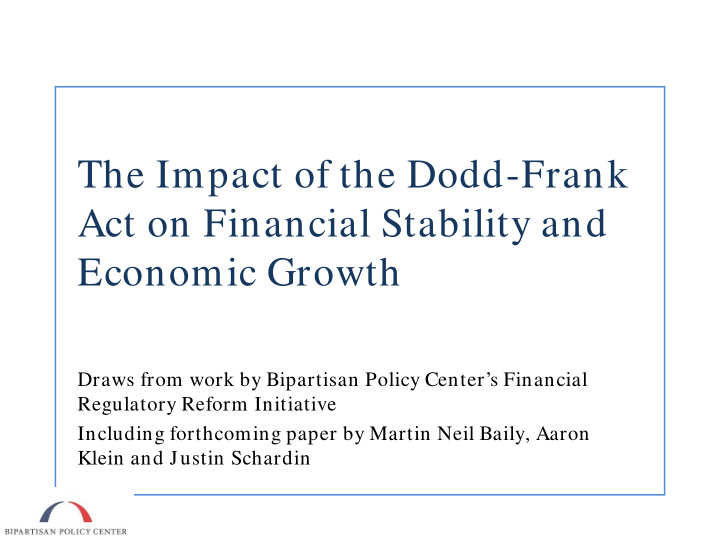



The Impact of the Dodd-Frank Act on Financial Stability and Economic Growth Draws from work by Bipartisan Policy Center’s Financial Regulatory Reform Initiative Including forthcoming paper by Martin Neil Baily, Aaron Klein and Justin Schardin
A framework for assessing Dodd-Frank The goal of the Dodd-Frank Wall Street Reform and Consumer Protection Act of 2010 was to increase financial stability to ensure that there would never be a repeat of the crisis of 2007-2009. We divide Dodd-Frank’s provisions into five sets, those that have: • Improved stability with positive impacts on both efficiency and economic growth or with strong impacts on stability with minimal impact on economic growth ( clear wins ) • Decreased financial stability without benefitting economic growth ( clear losses ) • Achieved little increase in stability at considerable cost to efficiency and economic growth ( costly trade-offs ) • Failed to adequately address a problem ( unfinished business ) • Created an uncertain trade-off between financial stability and economic growth ( too soon to tell ) 1
Costly Trade-Offs Clear Wins Resolution Increased Volcker Rule Process Capital Mandatory Lincoln CFPB Clearing Amendment Stability Regulatory Restrictions FSOC Consolidation on Crisis Authority OFR Clear Losses Did Not Go Far Enough Too Soon To Tell: Insurance Regulation
Validity Check: BPC Survey of Thought Leaders on Dodd-Frank Policies to Affect System ic Risk Higher equity capital requirements Stress tests Resolution authority Holding company debt requirements Derivative exchange and clearing Net Positive Single counterparty credit exposure limits Basel III leverage limits Living wills Creation of FSOC Non-bank SIFI designation authority Creation of OFR Financial utility SIFI designation authority Creation of Federal Insurance Office (FIO) Basel III liquidity requirements Credit risk retention rules Credit rating agency reforms Collins Amendment Volcker Rule Net Bank SIFI designation Product, activity, and practice limits Creation of CFPB Lincoln Amendment Limits on Fed and FDIC emergency authority 0 5 10 15 20 25 30 Differences in Responses Between More Likely to Decrease Risk and More Likely to Increase Risk Note: Survey pool was bipartisan thought leaders; not randomly selected or weighted 3
Clear losses: Restrictions on Fed and FDIC crisis authority The Fed stabilized multiple markets and prevented financial contagion. The FDIC guaranteed newly-issued bank debt. 4
Conclusions The financial sector is much safer today Increased capital requirements and stronger regulation and supervision has created a much safer financial sector. There is a clear path to ending TBTF The single point of entry strategy has been a breakthrough. It still requires further implementation and progress on cross-border resolution. Economic growth is a vital priority The regulatory system should be efficient and not inhibit lending to households and businesses provided risks are being priced and managed correctly. Regulators and supervisors should make sure bank staffs are doing their jobs but should not try to take over those jobs. 5
Recommend
More recommend